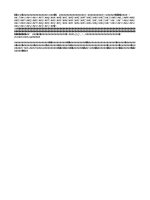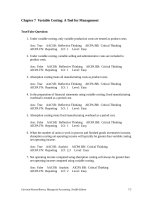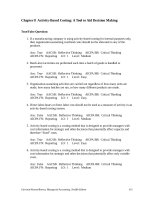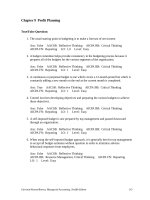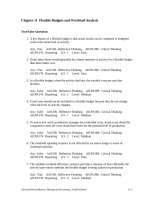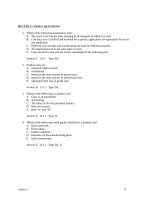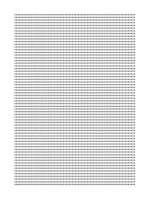Test bank managerial accounting by hilton 9e chapter13
Bạn đang xem bản rút gọn của tài liệu. Xem và tải ngay bản đầy đủ của tài liệu tại đây (170.62 KB, 39 trang )
MULTIPLE CHOICE QUESTIONS
1. The biggest challenge in making a decentralized organization function effectively is:
A. earning maximum profits through fair practices.
B. minimizing losses.
C. taking advantage of the specialized knowledge and skills of highly talented managers.
D. obtaining goal congruence among division managers.
E. developing an adequate budgetary control system.
Answer: D LO: 1 Type: RC
2. What practice is present when divisional managers throughout an organization work together
in an effort to achieve the organization's goals?
A. Participatory management.
B. Goal attainment.
C. Goal congruence.
D. Centralization of objectives.
E. Negotiation by subordinates.
Answer: C LO: 1 Type: RC
3. Consider the following statements about goal congruence:
I.
II.
III.
Goal congruence is obtained when managers of subunits throughout an organization
strive to achieve the goals set by top management.
Managers are often more concerned about the performance of their own subunits
rather than the performance of the entire organization.
Achieving goal congruence in most organizations is relatively straightforward and
easy to accomplish.
Which of the above statements is (are) true?
A. I only.
B. II only.
C. I and II.
D. II and III.
E. I, II, and III.
Answer: C LO: 1 Type: RC
Chapter 13
115
4. Which of the following performance measures is (are) used to evaluate the financial success or
failure of investment centers?
A. Residual income.
B. Return on investment.
C. Number of suppliers.
D. Economic value added.
E. All of the above measures are used except "C."
Answer: E LO: 1 Type: RC
5. ROI is most appropriately used to evaluate the performance of:
A. cost center managers.
B. revenue center managers.
C. profit center managers.
D. investment center managers.
E. both profit center managers and investment center managers.
Answer: D LO: 2 Type: RC
6. Which of the following is not considered in the calculation of divisional ROI?
A. Divisional income.
B. Earnings velocity.
C. Capital turnover.
D. Sales margin.
E. Sales revenue.
Answer: B LO: 2 Type: RC
7. Which of the following is the correct mathematical expression for return on investment?
A. Sales margin ÷ capital turnover.
B. Sales margin + capital turnover.
C. Sales margin - capital turnover.
D. Sales margin x capital turnover.
E. Capital turnover ÷ sales margin.
Answer: D LO: 2 Type: RC
8. The ROI calculation will indicate:
A. the percentage of each sales dollar that is invested in assets.
B. the sales dollars generated from each dollar of income.
C. how effectively a company used its invested capital.
D. the invested capital generated from each dollar of income.
E. the overall quality of a company's earnings.
Answer: C LO: 2 Type: RC
116
Hilton, Managerial Accounting, Seventh Edition
9. A company's sales margin:
A. must, by definition, be greater than the firm's net sales.
B. has basically the same meaning as the term "contribution margin."
C. is computed by dividing sales revenue into income.
D. is computed by dividing income into sales revenue.
E. shows the sales dollars generated from each dollar of income.
Answer: C LO: 2 Type: RC
10. Which of the following is the correct mathematical expression to derive a company's capital
turnover?
A. Sales revenue ÷ invested capital.
B. Contribution margin ÷ invested capital.
C. Income ÷ invested capital.
D. Invested capital ÷ sales revenue
E. Invested capital ÷ income
Answer: A LO: 2 Type: RC
11. Capital turnover shows:
A. the amount of income generated by each dollar of capital investment.
B. the number of sales dollars generated by each dollar of capital investment.
C. the amount of contribution margin generated by each dollar of capital investment.
D. the amount of capital investment generated by each sales dollar.
E. the amount of capital investment generated by each dollar of income.
Answer: B LO: 2 Type: RC
12. Webster Company had sales revenue and operating expenses of $5,000,000 and $4,200,000,
respectively, for the year just ended. If invested capital amounted to $6,000,000, the firm's
ROI was:
A. 13.33%.
B. 83.33%.
C. 120.00%.
D. 750.00%.
E. some other figure.
Answer: A LO: 2 Type: A
13. Zang Enterprises had a sales margin of 7%, sales of $5,000,000, and invested capital of
$4,000,000. The company's ROI was:
A. 5.60%.
B. 8.75%.
C. 11.43%.
D. 17.86%.
E. some other figure.
Answer: B LO: 2 Type: A
Chapter 13
117
14. Mission, Inc., reported a return on investment of 12%, a capital turnover of 5, and income of
$180,000. On the basis of this information, the company's invested capital was:
A. $300,000.
B. $900,000.
C. $1,500,000.
D. $7,500,000.
E. some other amount.
Answer: C LO: 2 Type: A
15. The information that follows relates to Katz Corporation:
Sales margin: 7.5%
Capital turnover: 2
Invested capital: $20,000,000
On the basis of this information, the company's sales revenue is:
A. $1,500,000.
B. $3,000,000.
C. $10,000,000.
D. $40,000,000.
E. some other amount.
Answer: D LO: 2 Type: A
16. A division's return on investment may be improved by increasing:
A. cost of goods sold and expenses.
B. sales margin and cost of capital.
C. sales revenue and cost of capital.
D. capital turnover or sales margin.
E. capital turnover or cost of capital.
Answer: D LO: 3 Type: RC
17. All of the following actions will increase ROI except:
A. an increase in sales revenues.
B. a decrease in operating expenses.
C. a decrease in a company's invested capital.
D. a decrease in the number of units sold.
E. an improvement in manufacturing efficiency.
Answer: D LO: 3 Type: N
118
Hilton, Managerial Accounting, Seventh Edition
18. Which of the following is used in the calculation of both return on investment and residual
income?
A. Total stockholders' equity.
B. Retained earnings.
C. Invested capital.
D. Total liabilities.
E. The cost of capital.
Answer: C LO: 2 Type: RC
19. Consider the following statements about residual income:
I.
II.
III.
Residual income incorporates a firm's cost of acquiring investment capital.
Residual income is a percentage measure, not a dollar measure.
If used correctly, residual income may result in division managers making decisions
that are in their own best interest and not in the best interest of the entire firm.
Which of the above statements is (are) true?
A. I only.
B. II only.
C. I and II.
D. II and III.
E. I and III.
Answer: A LO: 2, 4 Type: RC
20. The basic idea behind residual income is to have a division maximize its:
A. earnings per share.
B. income in excess of a corporate imputed interest charge.
C. cost of capital.
D. cash flows.
E. invested capital.
Answer: B LO: 2, 4 Type: N
21. Sunrise Corporation has a return on investment of 15%. A Sunrise division, which currently
has a 13% ROI and $750,000 of residual income, is contemplating a massive new investment
that will (1) reduce divisional ROI and (2) produce $120,000 of residual income. If Sunrise
strives for goal congruence, the investment:
A. should not be acquired because it reduces divisional ROI.
B. should not be acquired because it produces $120,000 of residual income.
C. should not be acquired because the division's ROI is less than the corporate ROI before
the investment is considered.
D. should be acquired because it produces $120,000 of residual income for the division.
E. should be acquired because after the acquisition, the division's ROI and residual income
are both positive numbers.
Answer: D LO: 4 Type: N
Chapter 13
119
22. The Fitzhugh Division of General Enterprises has a negative residual income of $540,000.
Fitzhugh's management is contemplating an investment opportunity that will reduce this
negative amount to $400,000. The investment:
A. should be pursued because it is attractive from both the divisional and corporate
perspectives.
B. should be pursued because it is attractive from the divisional perspective although not
from the corporate perspective.
C. should be pursued because it is attractive from the corporate perspective although not
from the divisional perspective.
D. should not be pursued because it is unattractive from both the divisional and corporate
perspectives.
E. should not be pursued because it is unattractive from the divisional perspective although it
is attractive from the corporate perspective.
Answer: A LO: 4 Type: N
23. The Magellan Division of Global Corporation, which has income of $250,000 and an asset
investment of $1,562,500, is studying an investment opportunity that will cost $450,000 and
yield a profit of $67,500. Assuming that Global uses an imputed interest charge of 14%,
would the investment be attractive to:
1—Divisional management if ROI is used to evaluate divisional performance?
2—Divisional management if residual income (RI) is used to evaluate divisional
performance?
3—The management of Global Corporation?
A.
B.
C.
D.
E.
Attractive to
Magellan: ROI
Yes
Yes
Yes
No
No
Attractive to
Magellan: RI
Yes
No
No
Yes
Yes
Attractive
to Global
Yes
No
Yes
Yes
No
Answer: D LO: 4 Type: A, N
24. The Georgia Division of Carter Companies currently reports a profit of $3.4 million.
Divisional invested capital totals $12.5 million; the imputed interest rate is 14%. On the basis
of this information, Georgia's residual income is:
A. $476,000.
B. $1,274,000.
C. $1,650,000.
D. $1,750,000.
E. some other amount.
Answer: C LO: 2 Type: A
120
Hilton, Managerial Accounting, Seventh Edition
25. The following information relates to the Mountain Division of Adler Enterprises:
Income for the period just ended: $1,500,000
Invested capital: $12,000,000
If the firm has an imputed interest rate of 11%, Mountain's residual income would be:
A. $165,000.
B. $180,000.
C. $187,500.
D. some other dollar amount.
E. a percentage greater than 11%.
Answer: B LO: 2 Type: A
26. Extron Division reported a residual income of $200,000 for the year just ended. The division
had $8,000,000 of invested capital and $1,000,000 of income. On the basis of this
information, the imputed interest rate was:
A. 2.5%.
B. 10.0%.
C. 12.5%.
D. 20.0%.
E. some other figure.
Answer: B LO: 2 Type: A
27. Barber Corporation uses an imputed interest rate of 13% in the calculation of residual income.
Division X, which is part of Barber, had invested capital of $1,200,000 and an ROI of 16%.
On the basis of this information, X's residual income was:
A. $24,960.
B. $36,000.
C. $156,000.
D. $192,000.
E. some other amount.
Answer: B LO: 2 Type: A, N
Use the following to answer questions 28-31:
The following information pertains to Bingo Concrete:
Sales revenue
Gross margin
Income
Invested capital
$1,500,000
600,000
90,000
450,000
The company's imputed interest rate is 8%.
Chapter 13
121
28. The capital turnover is:
A. 3.33.
B. 5.00.
C. 16.67.
D. 20.00.
E. 30.00.
Answer: A LO: 2 Type: A
29. The sales margin is:
A. 6%.
B. 15%.
C. 20%.
D. 30%.
E. 40%.
Answer: A LO: 2 Type: A
30. The ROI is:
A. 6%.
B. 15%.
C. 20%.
D. 30%.
E. 40%.
Answer: C LO: 2 Type: A
31. The residual income is:
A. $30,000.
B. $36,000.
C. $42,000.
D. $54,000.
E. $82,800.
Answer: D LO: 2 Type: A
32. For the period just ended, United Corporation's Delta Division reported
profit of $31.9 million and invested capital of $220 million. Assuming an
imputed interest rate of 12%, which of the following choices correctly
denotes Delta's return on investment (ROI) and residual income?
Return on
Residual
Investment
Income
A.
12.0%
$(5.5) million
B.
12.0%
$5.5 million
C.
14.5%
$(5.5) million
D.
14.5%
$5.5 million
E.
14.5%
$26.4 million
122
Hilton, Managerial Accounting, Seventh Edition
Answer: D LO: 2 Type: A
Chapter 13
123
33. For the period just ended, Price Corporation's Ohio Division reported profit
of $49 million and invested capital of $350 million. Assuming an imputed
interest rate of 16%, which of the following choices correctly denotes
Ohio's return on investment (ROI) and residual income?
Return on
Residual
Investment
Income
A. 14%
$7 million
B. 14%
$(7) million
C. 16%
$7 million
D. $7 million
14%
E. None of the above choices shows both the correct ROI and residual income.
Answer: B LO: 2 Type: A
34. Which of the following elements is not used when calculating the weighted-average cost of
capital?
A. Before-tax cost of debt capital.
B. After-tax cost of debt capital.
C. Cost of equity capital.
D. Market value of debt capital.
E. Market value of equity capital.
Answer: A LO: 2 Type: RC
35. The following information relates to the Atlantic Division of Ocean Enterprises:
Interest rate on debt capital: 8%
Cost of equity capital: 12%
Market value of debt capital: $50 million
Market value of equity capital: $80 million
Income tax rate: 30%
On the basis of this information, Atlantic's weighted-average cost of capital is:
A. 7.3%.
B. 8.3%.
C. 9.5%.
D. 10.8%.
E. some other figure.
Answer: C LO: 2 Type: A
124
Hilton, Managerial Accounting, Seventh Edition
36. The market value of Glendale’s debt and equity capital totals $180 million, 80% of which is
equity related. An analysis conducted by the company’s finance department revealed a 7%
after-tax cost of debt capital and a 10% cost of equity capital. On the basis of this
information, Glendale’s weighted-average cost of capital:
A. is 7.6%.
B. is 8.5%.
C. is 9.4%.
D. cannot be determined based on the data presented because the cost of debt capital must be
stated on a before-tax basis.
E. cannot be determined based on the data presented because the cost of equity capital must
be stated on an after-tax basis.
Answer: C LO: 2 Type: A, N
37. Which of the following measures of performance is, in part, based on the weighted-average
cost of capital?
A. Return on investment.
B. Capital turnover.
C. Book value.
D. Economic value added (EVA).
E. Gross margin.
Answer: D LO: 2 Type: RC
38. Which of the following elements is not used in the calculation of economic value added for an
investment center?
A. An investment center's after-tax operating income.
B. An investment center's total assets.
C. An investment center's return on investment.
D. An investment center's current liabilities.
E. A company's weighted-average cost of capital.
Answer: C LO: 2 Type: RC
39. Carolina Corporation has an after-tax operating income of $3,200,000 and a 9% weightedaverage cost of capital. Assets total $7,000,000 and current liabilities total $1,800,000. On
the basis of this information, Carolina's economic value added is:
A. $2,408,000.
B. $2,732,000.
C. $3,668,000.
D. $3,992,000.
E. some other amount.
Answer: B LO: 2 Type: A
Chapter 13
125
40. The following information relates to Houston, Inc.:
Total assets
After-tax operating income
Current liabilities
$9,000,000
1,500,000
800,000
If the company has a 10% weighted-average cost of capital, its economic value added would
be:
A. $(200,000).
B. $530,000.
C. $680,000.
D. $970,000.
E. some other amount.
Answer: C LO: 2 Type: A
41. Given that ROI measures performance over a period of time, invested capital would most
appropriately be figured by using:
A. beginning-of-year assets.
B. average assets.
C. end-of-year assets.
D. total assets.
E. only current assets.
Answer: B LO: 5 Type: RC
42. When an organization allows divisional managers to be responsible for short-term loans and
credit, the division's invested capital should be measured by
A. total assets minus total liabilities.
B. average total assets minus average current liabilities.
C. average total assets minus average total liabilities.
D. average total liabilities minus average current assets.
E. average total liabilities minus total assets.
Answer: B LO: 5 Type: RC
126
Hilton, Managerial Accounting, Seventh Edition
43. Hayes Division has been stagnant over the past five years, neither growing
nor contracting in size and profitability. Investments in new property,
plant, and equipment have been minimal. Would the division's use of total
assets (valued at net book value) when measuring ROI result in (1) using
numbers that are consistent with those on the balance sheet and (2) a
rising ROI over time?
Consistent with Numbers
Produce a Rising Return on
on the Balance Sheet?
Investment Over Time?
A.
Yes
Yes
B.
Yes
No
C.
No
Yes
D.
No
No
E.
Yes
Need more information
to judge
Answer: A LO: 5 Type: RC
44. The income calculation for a division manager's ROI should be based on:
A. divisional contribution margin.
B. profit margin controllable by the division manager.
C. profit margin traceable to the division.
D. divisional income before interest and taxes.
E. divisional net income.
Answer: B LO: 5 Type: RC
45. To partially eliminate the problems that are associated with the short-term focus of return on
investment, residual income, and EVA, the performance of a division's major investments is
commonly evaluated through:
A. postaudits.
B. sensitivity analysis.
C. performance operating plans.
D. horizontal analysis.
E. segmented reporting.
Answer: A LO: 5 Type: RC
46. The amounts charged for goods and services exchanged between two divisions are known as:
A. opportunity costs.
B. transfer prices.
C. standard variable costs.
D. residual prices.
E. target prices.
Answer: B LO: 6 Type: RC
Chapter 13
127
47. Nevada, Inc., has two divisions, one located in Las Vegas and the other
located in Reno. Las Vegas sells selected goods to Reno for use in various
end-products. Assuming that the transfer prices set by Las Vegas do not
influence the decisions made by the two divisions, which of the following
correctly describes the impact of the transfer prices on divisional profits
and overall company profit?
Las Vegas Profit
Reno Profit
Nevada Profit
A.
Affected
Affected
Affected
B.
Affected
Affected
Not affected
C.
Affected
Not affected
Affected
D.
Not affected
Not affected
Affected
E.
Not affected
Not affected
Not affected
Answer: B LO: 6 Type: RC
48. Thurmond, Inc., has two divisions, one located in New York and the other located in Arizona.
New York sells a specialized circuit to Arizona and just recently raised the circuit’s transfer
price. This price hike had no effect on the volume of circuits transferred nor on Arizona’s
option of acquiring the circuit from either New York or from an external supplier. On the
basis of this information, which of the following statements is most correct?
A.
The profit reported by New York will increase and the profit reported by Arizona will
decrease.
B.
The profit reported by New York will increase, the profit reported by Arizona will
decrease, and Thurmond’s profit will be unaffected.
C.
The profit reported by New York will decrease, the profit reported by Arizona will
increase, and Thurmond’s profit will be unaffected.
D.
The profit reported by New York will increase and the profit reported by Arizona will
increase.
E.
The profit reported by New York and the profit reported by Arizona will be
unaffected.
Answer: B LO: 6 Type: RC, N
49. Which of the following describes the goal that should be pursued when setting transfer prices?
A. Maximize profits of the buying division.
B. Maximize profits of the selling division.
C. Allow top management to become actively involved when calculating the proper dollar
amounts.
D. Establish incentives for autonomous division managers to make decisions that are in the
overall organization's best interests (i.e., goal congruence).
E. Minimize opportunity costs.
Answer: D LO: 6 Type: RC
128
Hilton, Managerial Accounting, Seventh Edition
50. A general calculation method for transfer prices that achieves goal congruence begins with the
additional outlay cost per unit incurred because goods are transformed and then
A. adds the opportunity cost per unit to the organization because of the transfer.
B. subtracts the opportunity cost per unit to the organization because of the transfer.
C. adds the sunk cost per unit to the organization because of the transfer.
D. subtracts the sunk cost per unit to the organization because of the transfer.
E. adds the sales revenue per unit to the organization because of the transfer.
Answer: A LO: 6 Type: RC
51. Suddath Corporation has no excess capacity. If the firm desires to implement the general
transfer-pricing rule, opportunity cost would be equal to:
A. zero.
B. the direct expenses incurred in producing the goods.
C. the total difference in the cost of production between two divisions.
D. the contribution margin forgone from the lost external sale.
E. the summation of variable cost plus fixed cost.
Answer: D LO: 6 Type: RC
52. Tulsa Corporation has excess capacity. If the firm desires to implement the general transferpricing rule, opportunity cost would be equal to:
A. zero.
B. the direct expenses incurred in producing the goods.
C. the total difference in the cost of production between two divisions.
D. the contribution margin forgone from the lost external sale.
E. the summation of variable cost plus fixed cost.
Answer: A LO: 6 Type: RC
53. McKenna's Florida Division is currently purchasing a part from an outside supplier. The
company's Alabama Division, which has excess capacity, makes and sells this part for external
customers at a variable cost of $22 and a selling price of $34. If Alabama begins sales to
Florida, it (1) will use the general transfer-pricing rule and (2) will be able to reduce variable
cost on internal transfers by $4. If sales to outsiders will not be affected, Alabama would
establish a transfer price of:
A. $18.
B. $22.
C. $30.
D. $34.
E. some other amount.
Answer: A LO: 6 Type: A
Chapter 13
129
54. AutoTech's Northern Division is currently purchasing a part from an outside supplier. The
company's Southern Division, which has no excess capacity, makes and sells this part for
external customers at a variable cost of $19 and a selling price of $31. If Southern begins
sales to Northern, it (1) will use the general transfer-pricing rule and (2) will be able to reduce
variable cost on internal transfers by $3. On the basis of this information, Southern would
establish a transfer price of:
A. $16.
B. $19.
C. $28.
D. $31.
E. some other amount.
Answer: C LO: 6 Type: A
Use the following to answer questions 55-57:
Laissez Faire has two divisions: the Cologne Division and the Bottle Division. The Bottle Division
produces containers that can be used by the Cologne Division. The Bottle Division's variable
manufacturing cost is $2, shipping cost is $0.10, and the external sales price is $3. No shipping costs
are incurred on sales to the Cologne Division, and the Cologne Division can purchase similar
containers in the external market for $2.60.
55. The Bottle Division has sufficient capacity to meet all external market demands in addition to
meeting the demands of the Cologne Division. Using the general rule, the transfer price from
the Bottle Division to the Cologne Division would be:
A. $2.00.
B. $2.10.
C. $2.60.
D. $2.90.
E. $3.00.
Answer: A LO: 6 Type: A
56. Assume the Bottle Division has no excess capacity and could sell everything it produced
externally. Using the general rule, the transfer price from the Bottle Division to the Cologne
Division would be:
A. $2.00.
B. $2.10.
C. $2.60.
D. $2.90.
E. $3.00.
Answer: D LO: 6 Type: A
130
Hilton, Managerial Accounting, Seventh Edition
57. The maximum amount the Cologne Division would be willing to pay for each bottle
transferred would be:
A. $2.00.
B. $2.10.
C. $2.60.
D. $2.90.
E. $3.00.
Answer: C LO: 6 Type: A
58. Transfer prices can be based on:
A. variable cost.
B. full cost.
C. an external market price.
D. a negotiated settlement between the buying and selling divisions.
E. all of the above.
Answer: E LO: 7 Type: RC
59. Which of the following transfer-pricing methods can lead to dysfunctional decision-making
behavior by managers?
A. Variable cost.
B. Full cost.
C. External market price.
D. A professionally negotiated, amicable settlement between the buying and selling
divisions.
E. None of the above.
Answer: B LO: 7 Type: RC
60. The Pro Division of Custom Industries is in need of a particular service. The service can be
obtained from another division of Custom at "cost," with cost defined as the summation of
variable cost ($9) and fixed cost ($3). Alternatively, Pro can secure the service from a source
external to Custom for $10. Which of the following statements is true?
A. Pro should compare $10 vs. $3 in deciding where to acquire the service.
B. Pro should compare $10 vs. $9 in deciding where to acquire the service.
C. Pro should compare $10 vs. $12 in deciding where to acquire the service.
D. From Custom's perspective, the proper decision is reached by comparing $10 vs. $9.
E. Both "C" and "D" are true.
Answer: E LO: 7 Type: A, N
Chapter 13
131
61. Division A transfers item no. 78 to Division B. Consider the following situations:
1—A is located in Texas and B is located in California.
2—A is located in Texas and B is located in Mexico.
Assuming that item no. 78 is unavailable in the open market, which of the
following choices correctly depicts the probable importance of federal
income taxes when determining the transfer price that is established for
item no. 78?
Situation 1
Situation 2
A. Important
Important
B. Important
Not important
C. Not important
Important
D. Not important
Not important
E. It is not possible to judge based on the information presented.
Answer: C LO: 7 Type: N
62. Division A transfers a profitable subassembly to Division B, where it is
assembled into a final product. A is located in a European country that has
a high tax rate; B is located in an Asian country that has a low tax rate.
Ideally, (1) what type of before-tax income should each division report
from the transfer and (2) what type of transfer price should be set for the
subassembly?
Division A
Division B
Transfer
Income
Income
Price
A.
Low
Low
Low
B.
Low
High
Low
C.
Low
High
High
D.
High
Low
High
E.
High
High
Low
Answer: B LO: 7 Type: N
63. Consider the following statements about transfer pricing:
I.
II.
III.
Income taxes and import duties are an important consideration when setting a transfer
price for companies that pursue international commerce.
Transfer prices cannot be used by organizations in the service industry.
Transfer prices are totally cost-based in nature, not market-based.
Which of the above statements is (are) true?
A. I only.
B. II only.
C. I and II.
D. II and III.
E. I, II, and III.
132
Hilton, Managerial Accounting, Seventh Edition
Answer: A LO: 7 Type: RC
Chapter 13
133
EXERCISES
Components of Return on Investment
64. The following data pertain to Corkscrew Corporation:
Income
Sales revenue
Average invested capital
$ 8,000,000
40,000,000
50,000,000
Required:
Calculate Corkscrew Corporation's sales margin, capital turnover, and return on investment.
LO: 2 Type: A
Answer:
Sales margin: $8,000,000 ÷ $40,000,000 = 20%
Capital turnover: $40,000,000 ÷ $50,000,000 = 0.8
Return on investment: $8,000,000 ÷ $50,000,000 = 16%
Components of ROI and Residual Income: Working Backward
65. Midland Division, which is part of Courtyard Enterprises, recently reported a sales margin of
30%, ROI of 21%, and residual income of $220,000. Courtyard uses an imputed interest rate
of 10%.
Required:
A. Briefly define sales margin, capital turnover, and return on investment.
B. Compute Midland's capital turnover and invested capital.
C. Ignoring your work in requirement "B," assume that invested capital amounted to
$2,500,000. On the basis of this information, calculate Midland's income and sales
revenue.
LO: 2 Type: A, N
134
Hilton, Managerial Accounting, Seventh Edition
Answer:
A. Sales margin—the income generated from each sales dollar.
Computed as: Income ÷ sales revenue.
Capital turnover—the sales dollars produced from each dollar of invested capital.
Computed as: Sales revenue ÷ invested capital.
Return on investment—the income generated from each dollar of invested capital.
Computed as: Income ÷ invested capital, or sales margin x capital turnover.
B. Capital turnover:
Capital turnover x sales margin = ROI
Capital turnover x 30% = 21%
Capital turnover = 0.7
Invested capital:
ROI = Income ÷ invested capital
21% = Income ÷ invested capital
Income = Invested capital x 21%
Residual income = Income - (invested capital x imputed interest rate)
$220,000 = Income - (invested capital x 10%)
$220,000 = (Invested capital x 21%) - (invested capital x 10%)
$220,000 = Invested capital x 11%
Invested capital = $2,000,000
C.
Income:
ROI = Income ÷ invested capital
21% = Income ÷ $2,500,000
Income = $525,000
Sales revenue:
Sales margin = Income ÷ sales revenue
30% = $525,000 ÷ sales revenue
Sales revenue = $1,750,000
Chapter 13
135
Economic Value Added, Weighted-Average Cost of Capital
66. The following data pertain to Dana Industries:
Interest rate on debt capital: 9%
Cost of equity capital: 12%
Before-tax operating income: $35 million
Market value of debt capital: $60 million
Market value of equity capital: $120 million
Total assets: $150 million
Income tax rate: 30%
Total current liabilities: $15 million
Required:
A. Compute Dana’s weighted-average cost of capital.
B. Compute Dana’s economic value added.
C. Briefly explain the meaning of economic value added.
LO: 2 Type: RC, A
Answer:
A. WACC = [(9% x 70%) x $60,000,000) + (12% x $120,000,000)] ÷ ($60,000,000 +
$120,000,000)
WACC = ($3,780,000 + $14,400,000) ÷ $180,000,000
WACC = 10.1%
B. EVA = ($35,000,000 x 70%) - [($150,000,000 - $15,000,000) x 10.1%]
EVA = $24,500,000 - $13,635,000
EVA = $10,865,000
C. Economic value added (EVA) measures the amount of shareholder wealth being created
from a company’s activities and operations. To expand, debt and equity capital are used to
fund activities—activities that are hopefully conducted in a profitable manner. Profits
cover the cost of the related capital, with shareholders benefiting from the residual (i.e.,
EVA).
136
Hilton, Managerial Accounting, Seventh Edition
Improving Return on Investment
67. The following data pertain to Norris Company for 20x1:
Sales revenue
Cost of goods sold
Operating expenses
Average invested capital
$1,000,000
550,000
400,000
500,000
Required:
A. Calculate the company's sales margin, capital turnover, and return on investment for 20x1.
B. If the sales and average invested capital remain the same, to what level would total costs
and expenses have to be reduced in 20x2 to achieve a 15% return on investment?
C. Assume that costs and expenses are reduced, as calculated in requirement "B." Calculate
the firm's new sales margin.
D. Suggest two possible actions that will improve the company's capital turnover.
LO: 2, 3 Type: A, N
Answer:
A. Sales revenue
Less: Cost of goods sold
Operating expenses
Operating income
$1,000,000
$550,000
400,000
$
950,000
50,000
Sales margin: $50,000 ÷ $1,000,000 = 5%
Capital turnover: $1,000,000 ÷ $500,000 = 2
Return on investment: $50,000 ÷ $500,000 = 10%
B.
New income level: $500,000 x 15% = $75,000
Sales revenue
Less: Income
Costs and expenses
$1,000,000
75,000
$ 925,000
Therefore, total costs and expenses must be reduced from $950,000 ($550,000 +
$400,000) to $925,000 in order to achieve a 15% ROI.
C.
Sales margin: $75,000 ÷ $1,000,000 = 7.5%
D.
Capital turnover can be improved by increasing sales revenue and reducing invested
capital.
Chapter 13
137
Return on Investment and Residual Income: Calculation and Analysis
68. The following data pertain to the Oxnard Division of Kemp Company:
Divisional contribution margin
Profit margin controllable by the divisional manager
Profit margin traceable to the division
Average asset investment
$ 700,000
320,000
294,400
1,280,000
The company uses responsibility accounting concepts when evaluating performance, and
Oxnard's division manager is contemplating the following three investments. He can invest up
to $400,000.
Cost
Expected income
No. 1
$250,000
50,000
No. 2
$300,000
54,000
No. 3
$400,000
96,000
Required:
A. Calculate the ROIs of the three investments.
B. What is the division manager's current ROI, computed by using responsibility accounting
concepts?
C. Which of the three investments would be selected if the manager's focus is on Oxnard's
divisional performance? Why?
D. If Kemp has an imputed interest charge of 22%, compute the residual income of
investment no. 3. Is this investment attractive from Oxnard's perspective? From Kemp's
perspective? Why?
LO: 2, 4 Type: A, N
Answer:
A. No. 1: $50,000 ÷ $250,000 = 20%
No. 2: $54,000 ÷ $300,000 = 18%
No. 3: $96,000 ÷ $400,000 = 24%
B.
Controllable profit margin ($320,000) ÷ asset investment ($1,280,000) = 25%
C.
None, as all will lower the current ROI.
D.
Residual income: $96,000 - ($400,000 x 22%) = $8,000
This investment is attractive from both Oxnard and Kemp's perspectives. The positive
residual income indicates that the investment income covers the imputed interest
charge.
138
Hilton, Managerial Accounting, Seventh Edition
ROI and Residual Income, Investment Evaluation
69. Jasper Corporation is organized in three separate divisions. The three divisional managers are
evaluated at year-end, and bonuses are awarded based on ROI. Last year, the overall company
produced a 12% return on its investment.
Managers of Jasper's Iowa Division recently studied an investment opportunity that would
assist in the division's future growth. Relevant data follow.
Income
Invested capital
Iowa
Division
$12,800,000
80,000,000
Investment
Opportunity
$ 4,200,000
30,000,000
Required:
A. Compute the current ROI of the Iowa Division and the division's ROI if the investment
opportunity is pursued.
B. What is the likely reaction of divisional management toward the acquisition? Why?
C. What is the likely reaction of Jasper's corporate management toward the investment?
Why?
D. Assume that Jasper uses residual income to evaluate performance and desires an 11%
minimum return on invested capital. Compute the current residual income of the Iowa
Division and the division's residual income if the investment is made. Will divisional
management likely change its attitude toward the acquisition? Why?
LO: 2, 4 Type: A, N
Chapter 13
139
